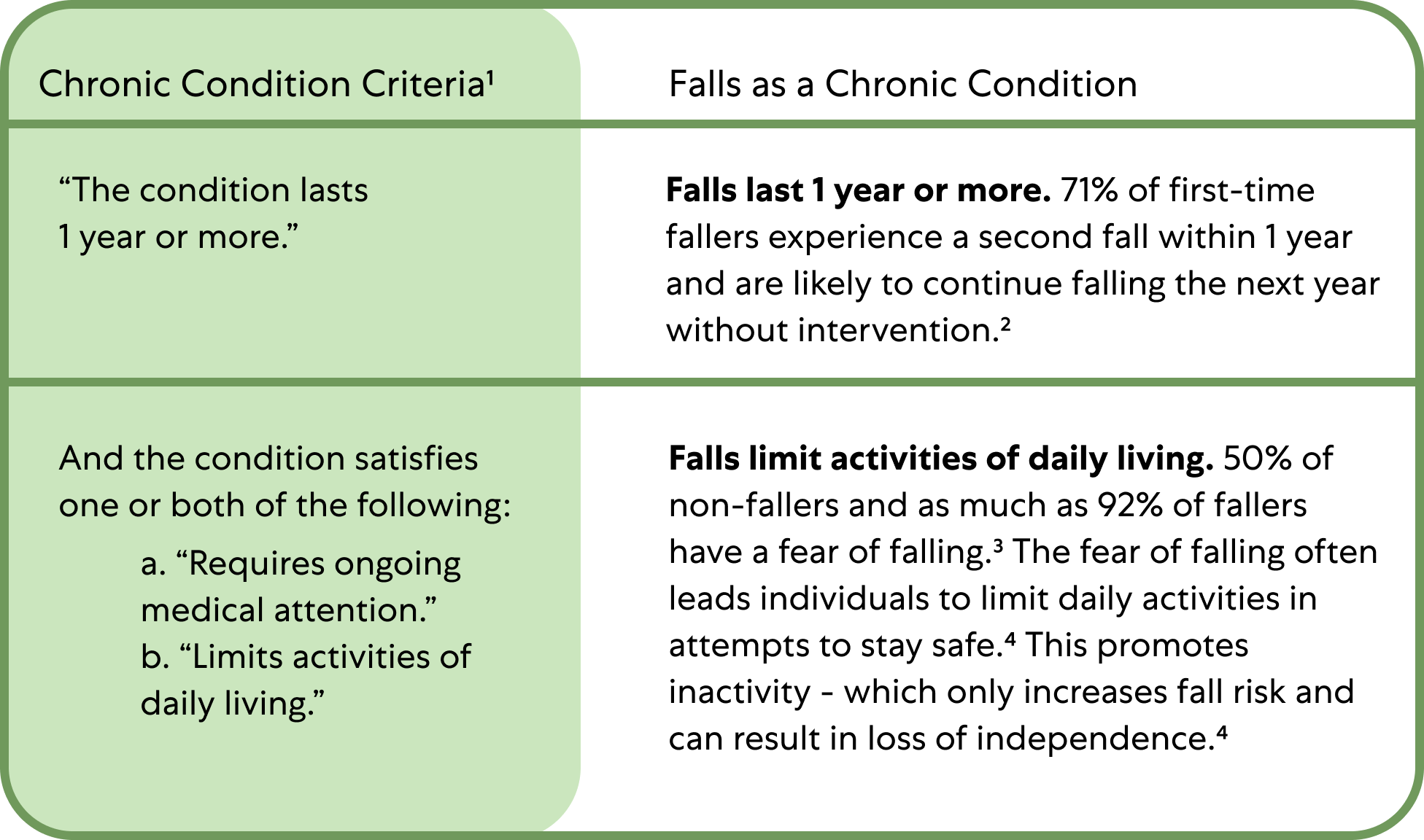Are Falls a Chronic Condition?
Should we define falls as a chronic condition?
The problem of falls among older adults has taken the shape of a silent epidemic. 1 in 4 older adults experience a fall each year. But, many health plans underestimate the prevalence and cost of falls due to frequent inaccurate reporting.
In our most recent whitepaper, Balance and Aging: Understanding How Aging Impacts Decline in Balance, we prove that falls should be considered a chronic condition. Among other pieces of evidence, our investigation shows that falls meet the Centers for Disease Control and Prevention’s (CDC) definition of a chronic condition.

As described in the table above, falls meet each of the CDC’s criteria for chronic conditions. Further, it can be argued that fallers eventually “require ongoing medical attention.”
Without intervention, the impact of recurrent falls can generate inactivity as fallers limit their daily activities to avoid what they perceive as risky situations. This inactivity can bring a gradual decline in quality of life, requiring increasingly frequent medical attention and eventually leading to a full loss of independence.
"Although the desire to avoid further falls leads to a restriction of activity, it also sets in motion a loss of independence resulting from decreased strength, balance, and endurance, which further increases the risk of falling."5
In addition to the CDC’s definition, the cost of falls also aligns with the costs of other chronic conditions. In Nymbl’s Balance and Aging report, we further expand on why we should consider falls a chronic condition, how balance decline occurs as we age, and how the growing older adult population is leading to rising cost of falls.
We also explain why Nymbl is positioned to become the standard of care for fall prevention as the only solution with a proven population-wide impact for MA plans. In addition to delivering cost savings, Nymbl can also impact Star ratings.
Members using Nymbl were 38% more likely to say they had discussed fall risk with their provider.6
Sources:
- Goodman RA, Posner SF, Huang ES, Parekh AK, Koh HK. Defining and Measuring Chronic Conditions: Imperatives for Research, Policy, Program, and Practice. Prev Chronic Dis 2013;10:120239. DOI: http://dx.doi.org/10.5888/pcd10.120239.
- Axene. The Cost of Chronic Conditions vs. Falls for Medicare Advantage. CMS LDS 5% sample for 2022, 2024. https://info.nymblscience.com/the-cost-of-falls.
- Courtney T, Estrada N, Mirsky B. Identifying Medical Spend for Older Adults with Injurious Fall Related Claims- Lessons Learned. Wakely x Nymbl White Paper. April 2023, https://5113115.fs1.hubspotusercontent-na1.net/hubfs/5113115/White%20Papers/Identifying%20Medical%20Spend%20Older%20Adults%20Injurious%20Fall-Related%20Claims%20-%20Lessons%20Learned.pdf.
- Lee D, Tak SH. A concept analysis of fear of falling in older adults: insights from qualitative research studies. BMC Geriatr. 2023 Oct 11;23(1):651. doi: 10.1186/s12877-023-04364-5. PMID: 37821830; PMCID: https://www.ncbi.nlm.nih.gov/pmc/articles/PMC10568775/.
- Petrella RJ, Payne M, Myers A, Overend T, Chesworth B. Physical function and fear of falling after hip fracture rehabilitation in the elderly. Am J Phys Med Rehabil. 2000 Mar-Apr;79(2):154-60. PMID: 10744190. https://pubmed.ncbi.nlm.nih.gov/10744190/.
- Goe, J. Nymbl Science’s Stars Impact. Nymbl White Paper, August 2023. https://5113115.fs1.hubspotusercontent-na1.net/hubfs/5113115/White%20Papers/Nymbl%20Science%E2%80%99s%20Stars%20Impact.pdf.

In a recent report from AARP, it's clear that older adults are not just catching up with technology—they're embracing it. The report reveals a significant shift in attitudes towards technology among individuals ages 50+, signaling a new era of tech-savviness in this demographic.
On the flip side, nearly two-thirds (64%) of adults ages 50+ feel that today’s technology isn’t tailored to their needs, according to the same AARP report.
Key Takeaways Include:
-
- Tech Adoption on the Rise: Gone are the days when older adults shied away from technology. Today, they're increasingly recognizing the benefits and convenience that tech tools offer.
- Changing Mindsets: The report sheds light on the evolving attitudes towards technology among older adults, showcasing a growing willingness to embrace new gadgets and integrate them seamlessly into their daily routines.
- Enhancing Life with Tech: From staying connected with loved ones to managing healthcare needs and beyond, technology is viewed as a valuable tool for enhancing various aspects of life for older adults.
- A Shift Towards Tech-Savviness: With older adults becoming more adept at navigating the digital landscape, the findings suggest a promising trend towards greater tech fluency in this age group.
- Opportunity For a More Inclusive Approach: The findings underscore the need for a more inclusive approach to tech, such as product design, support, and education, to better serve older adults.
Nymbl was created specifically as a digital program for older adults.
Drawing from extensive research and collaborating closely with experts in gerontology, physical therapy, and cognitive science, Nymbl designs exercises and activities that prioritize safety, effectiveness, and enjoyment.
Programs are personalized to accommodate varying fitness levels and abilities, with a focus on progressions and adaptive challenges.
By integrating evidence-based approaches, Nymbl empowers older adults to maintain or improve balance and mobility while fostering confidence and a sense of accomplishment in their health journey.
Follow us on LinkedIn | Learn more at Nymblscience.com


.png?width=50&height=50&name=pngegg(1).png)
-1.png?width=50&height=50&name=pngegg(2)-1.png)
